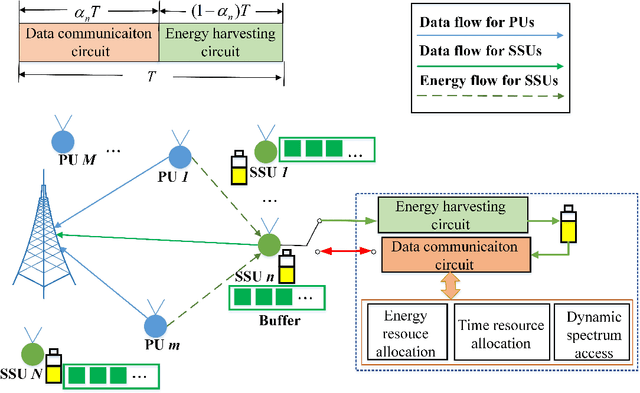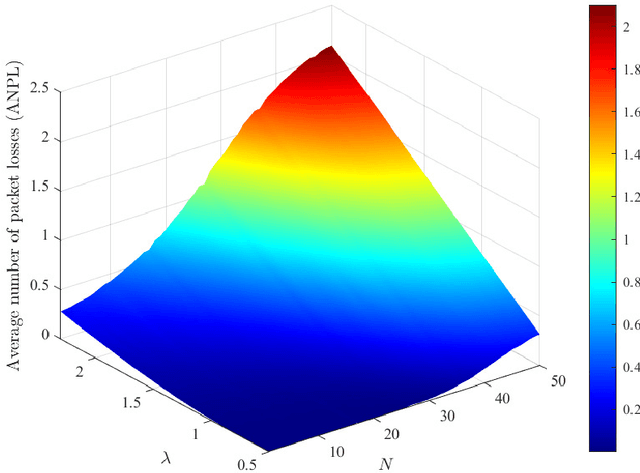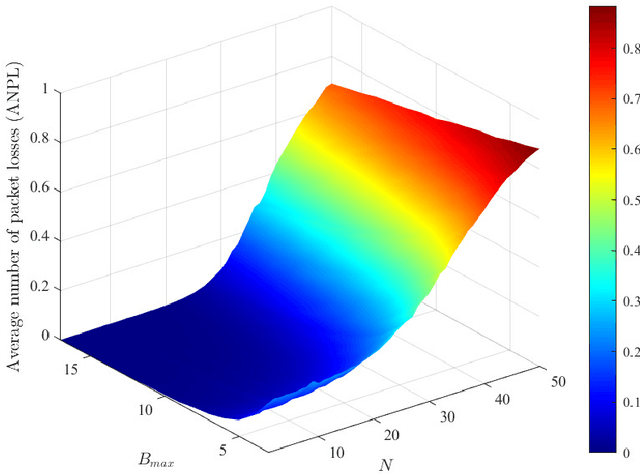Xianzhong Xie
Active RIS-aided EH-NOMA Networks: A Deep Reinforcement Learning Approach
Apr 11, 2023Abstract:An active reconfigurable intelligent surface (RIS)-aided multi-user downlink communication system is investigated, where non-orthogonal multiple access (NOMA) is employed to improve spectral efficiency, and the active RIS is powered by energy harvesting (EH). The problem of joint control of the RIS's amplification matrix and phase shift matrix is formulated to maximize the communication success ratio with considering the quality of service (QoS) requirements of users, dynamic communication state, and dynamic available energy of RIS. To tackle this non-convex problem, a cascaded deep learning algorithm namely long short-term memory-deep deterministic policy gradient (LSTM-DDPG) is designed. First, an advanced LSTM based algorithm is developed to predict users' dynamic communication state. Then, based on the prediction results, a DDPG based algorithm is proposed to joint control the amplification matrix and phase shift matrix of the RIS. Finally, simulation results verify the accuracy of the prediction of the proposed LSTM algorithm, and demonstrate that the LSTM-DDPG algorithm has a significant advantage over other benchmark algorithms in terms of communication success ratio performance.
A Constrained Deformable Convolutional Network for Efficient Single Image Dynamic Scene Blind Deblurring with Spatially-Variant Motion Blur Kernels Estimation
Aug 23, 2022



Abstract:Most existing deep-learning-based single image dynamic scene blind deblurring (SIDSBD) methods usually design deep networks to directly remove the spatially-variant motion blurs from one inputted motion blurred image, without blur kernels estimation. In this paper, inspired by the Projective Motion Path Blur (PMPB) model and deformable convolution, we propose a novel constrained deformable convolutional network (CDCN) for efficient single image dynamic scene blind deblurring, which simultaneously achieves accurate spatially-variant motion blur kernels estimation and the high-quality image restoration from only one observed motion blurred image. In our proposed CDCN, we first construct a novel multi-scale multi-level multi-input multi-output (MSML-MIMO) encoder-decoder architecture for more powerful features extraction ability. Second, different from the DLVBD methods that use multiple consecutive frames, a novel constrained deformable convolution reblurring (CDCR) strategy is proposed, in which the deformable convolution is first applied to blurred features of the inputted single motion blurred image for learning the sampling points of motion blur kernel of each pixel, which is similar to the estimation of the motion density function of the camera shake in the PMPB model, and then a novel PMPB-based reblurring loss function is proposed to constrain the learned sampling points convergence, which can make the learned sampling points match with the relative motion trajectory of each pixel better and promote the accuracy of the spatially-variant motion blur kernels estimation.
Outage Performance of Uplink Rate Splitting Multiple Access with Randomly Deployed Users
May 03, 2022



Abstract:Rate splitting multiple access (RSMA) is a promising solution to improve spectral efficiency and provide better fairness for the upcoming sixth-generation (6G) networks. In this paper, the outage performance of uplink RSMA transmission with randomly deployed users is investigated, taking both user scheduling schemes and power allocation strategies into consideration. Specifically, the greedy user scheduling (GUS) and cumulative distribution function (CDF) based user scheduling (CUS) schemes are considered, which could maximize the rate performance and guarantee access fairness, respectively. Meanwhile, we re-investigate cognitive power allocation (CPA) strategy, and propose a new rate-fairness oriented power allocation (FPA) strategy to enhance the scheduled users rate fairness. By employing order statistics and stochastic geometry, an analytical expression of the outage probability for each scheduling scheme combining power allocation is derived to characterize the performance. To get more insights, the achieved diversity order of each scheme is also derived. Theoretical results demonstrate that both GUS and CUS schemes applying CPA or FPA strategy can achieve full diversity orders, and the application of CPA strategy in RSMA can effectively eliminate the secondary user's diversity order constraint from the primary user. Simulation results corroborate the accuracy of the analytical expressions, and show that the proposed FPA strategy can achieve excellent rate fairness performance in high signal-to-noise ratio region.
Deep Reinforcement Learning Based Multidimensional Resource Management for Energy Harvesting Cognitive NOMA Communications
Sep 17, 2021



Abstract:The combination of energy harvesting (EH), cognitive radio (CR), and non-orthogonal multiple access (NOMA) is a promising solution to improve energy efficiency and spectral efficiency of the upcoming beyond fifth generation network (B5G), especially for support the wireless sensor communications in Internet of things (IoT) system. However, how to realize intelligent frequency, time, and energy resource allocation to support better performances is an important problem to be solved. In this paper, we study joint spectrum, energy, and time resource management for the EH-CR-NOMA IoT systems. Our goal is to minimize the number of data packets losses for all secondary sensing users (SSU), while satisfying the constraints on the maximum charging battery capacity, maximum transmitting power, maximum buffer capacity, and minimum data rate of primary users (PU) and SSUs. Due to the non-convexity of this optimization problem and the stochastic nature of the wireless environment, we propose a distributed multidimensional resource management algorithm based on deep reinforcement learning (DRL). Considering the continuity of the resources to be managed, the deep deterministic policy gradient (DDPG) algorithm is adopted, based on which each agent (SSU) can manage its own multidimensional resources without collaboration. In addition, a simplified but practical action adjuster (AA) is introduced for improving the training efficiency and battery performance protection. The provided results show that the convergence speed of the proposed algorithm is about 4 times faster than that of DDPG, and the average number of packet losses (ANPL) is about 8 times lower than that of the greedy algorithm.
 Add to Chrome
Add to Chrome Add to Firefox
Add to Firefox Add to Edge
Add to Edge